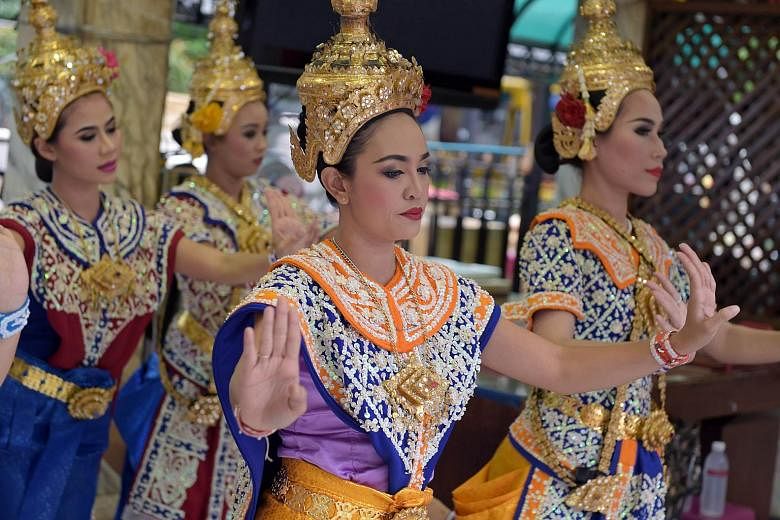BANGKOK (AFP) - Hands clasped together before the four-faced Hindu god Brahma, Bangkok's glimmering temple dancers were back on stage on Friday, four days after a bomb tore through the shrine thronged daily by devotees.
Ms Sunisa Pothisansuk was midway through an act she has performed every other day for eight years when the blast struck Erawan Shrine, escaping unscathed from an attack that killed 20 people, mostly Asian tourists, and left scores injured.
"It was like Brahma helped me. It's a miracle that we survived," said the 26-year-old, her face streaming with tears for those who did not.
Dressed in a richly sequinned blue and red traditional costume, the dancer prepared to return to the stage for the first time since the blast spared the lives of her fellow dancers and musicians.
"We were dancing, everything was so normal. Then suddenly there was a big bang," said Ms Sunisa who was in the back row when the blast whipped off the mirrored headdress now positioned perfectly in place.
Dazed but still standing, the troupe managed to leave the shrine nestled between high-end hotels and malls in the bustling downtown district with Bangkok's elevated metro track looming above.
Just two days later, when the Erawan reopened, visitors were back in force, the air once again filled with the scent of incense as the faithful adorned the railings surrounding the golden statue of Brahma, known locally as Phra Phrom, with marigold and jasmine garlands.
The Erawan is beloved in Buddhist-majority Thailand where the faith has long forged a syncretic relationship with animist and Hindu traditions - shrines to the Hindu gods Ganesha and Shiva can be found just a few hundred metres away.
Temple dancers have performed their graceful steps and sung religious songs for 30 years, said Mr Anuwat Panprayon, who manages the troupes that perform in shifts from morning till night under a covered pavilion opposite the statue.
"I think Brahma was protecting us," Mr Anuwat told AFP, echoing the other dancers, standing next to the spot where he had been seated when the blast hit. "Everybody under this roof was protected."
In recent years, Chinese devotees in particular have congregated at the shrine, fuelled by the belief that prayers and donations there will bring them good luck.
Many are also following in the footsteps of popular Chinese and Hong Kong film stars whose photographs at the Erawan have inspired others to visit.
After lighting a candle in memory of the dead and in honour of the shrine, Ms Piyawan Muangkhong, 26, stepped barefoot onto the stage.
The high-pitched notes of the xylophone and a double-faced Thai drum opened the performance of seven of the same group that had been dancing on Monday.
Ms Piyawan, who began training as a dancer at the age of six under the tuition of her aunt, joined the others in singing devotional verses before stretching into the slow and sombre dance.
Despite the fresh memories of dismembered limbs and wounded bodies just four days earlier the group of dancers said they felt only sadness, not nerves, in returning to the scene.
"Maybe it wasn't my time to die," said Ms Piyawan.

